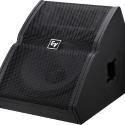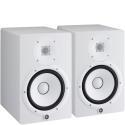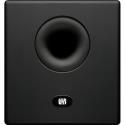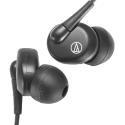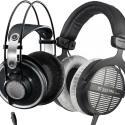Studio Monitors vs Speakers: Let's Be Clear. Read This
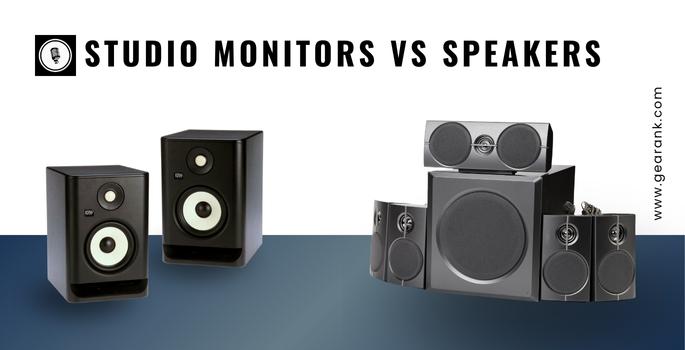
Studio Monitors vs SpeakersStudio monitors are used in studio setups for critical listening, while regular speakers are meant for casual listening or general entertainment purposes. |
If you want to purchase speakers, you may have encountered the terms studio monitors and speakers. But what is the difference between studio monitors vs speakers?
It is crucial to comprehend the significance of the speakers you use in music production, as they can significantly affect the quality of your work's sound.
This guide will discuss the differences between studio monitors and regular speakers.
My goal is to help you choose the best speaker for your needs, whether you are a casual listener or a critical one.
What are Studio Monitors and Speakers?
Studio Monitors: Studio monitors are designed to have a flat frequency response. The audio produced by these speakers is an accurate sound without any coloration. This makes them ideal for music, audio production, and professional studio recording.
They're not designed to produce more bass or sound better in a given space but to produce a precise sound profile. As a result, studio monitors play music and audio in general, with clarity as close as it gets to how it should originally sound.
Speakers: Regular speakers, however, are designed for general listening. They are designed for your home, like living rooms, home theaters, etc. They can also be for your personal space, like in your room.
What regular consumer speakers do is deliver a good audio-listening experience. This means producing a colored or modified audio frequency. It can be by boosting the bass, mids, or treble. They can also include spatial effects like reverb to enhance the overall quality of the audio.
Studio Monitors vs Speakers: Their Differences
Understanding the technical differences will let you choose the correct type for your needs.
The main differences between a regular speaker and a studio monitor are:
-
General Use: Studio monitors are used in studio setups for critical listening. Meanwhile, normal hi-fi speakers and bluetooth speakers are used for casual listening or general entertainment purposes.
-
Sound: Studio monitors are designed to produce accurate, true-to-life sound quality. This is often achieved with a good mid range speaker paired with a tweeter. While consumer speakers are enhanced and designed to sound good.
Studio monitors are mostly active and have multiple built-in power amplifiers. Each powered speaker has a dedicated power amplifier for each frequency for a more accurate sound.
A home monitor speaker, in general, only has one power amp. As a result, these speakers produce sounds that are less accurate to the source but more focused on sounding good.
-
Configuration: When considering your options for audio playback, it's important to consider whether you'll want a stereo vs mono configuration.
Most of the best studio monitors tend to have active speakers. They have individual power amplifiers on each of their woofers and tweeters. This means they do not need an external amp to function. This is comparable to a combo amp setup.
Home speakers, on the other hand, are mostly passive speakers. Meaning bookshelf speakers need an external amp to operate. This passive speaker setup resembles that of an amp head and speaker cabinet configuration.
-
Range: Dedicated monitor speakers are for nearfield usage, meaning they sound best when you're close to the source. Regular speakers, on the other hand, are usually mid-to-far field ranges. This means that they sound best when listening from a distance. Note that monitors are not meant for loud use, as audio clipping can negatively impact audio fidelity.
-
Design: Studio monitors are compact and are typically designed for a tighter space. Most home speakers' aesthetics are sleek, allowing them to blend with a particular home setup or even look like furniture.
Why Use Studio Monitors?
Studio monitors are essential in music production, providing audio accuracy and precision that cannot be achieved with regular speakers or headphones.
These monitors are designed to produce a flat frequency response, meaning they do not add any extra coloration to the sound during playback.
When paired with an audio interface, studio monitors are crucial for recording, mixing, and mastering, as it allows producers to hear every detail in the music and make precise adjustments to achieve the desired sound.
Many studio monitors have specially designed waveguides that direct sound waves to achieve a "sweet spot" when pointed to the listener at an angle.
Studio monitors are not just limited to professional recording studios but are also widely used in home studios and for personal listening.
Home music studio owners and music enthusiasts who value high-quality sound reproduction choose studio monitors for audio playback. Unlike consumer speakers, studio monitors are designed to provide an unadulterated sound that accurately represents the original recording.
How to Choose a Studio Monitor
Size of the Room: The larger the area, the more power it requires to fill it with sound. You can afford to have compact monitors if your room is smaller.
Active and Passive Speakers: While most studio monitors are active and do not require an amp, some still do. It's essential to consider the configuration you want based on your space and needs.
Size and Type of Drivers: Differences in driver size (woofers and tweeters) also matter. It can impact the frequency response and overall sound quality.
Range: Identify the type of monitor speakers for your home studio. Near field speakers like the KRK Rokit RP5 G4, PreSonus Eris E3.5, and Yamaha HS5 have a range of 3 to 5 feet.
While midfield monitors like the KS Digital C88 reference, Neumann KH 420, and FocalTrio11 BE have a wider range.
Price: Investing in high-quality products always pays off, especially in music production. However, if you're experiencing financial constraints, many budget-friendly alternatives that can serve the purpose are still available in the market.
Though they may not match the superior quality of premium products, they can still provide adequate functionality. The key aspect to consider is having a speaker capable of monitoring your music production accurately.
Brand Name: When selecting studio monitors, it is advisable to opt for well-known brands. Popular brands typically have more sales and, thus, more reviews. You can use these reviews as a guide to help you choose the right studio monitor for your needs.
Final Thoughts
When deciding between studio monitors vs speakers, it's important to consider the type of sound you're aiming for.
Studio monitors are the best option for accurate and professional audio listening, thanks to their ability to detect sound imperfections and imbalances in your mix. This is crucial when music professionals listen to a mix, in settings where sound quality is paramount. However, if you're looking for casual music listening, regular speakers can work fine and provide good general audio quality.
Studio monitors have a flat frequency response, which means they don't artificially boost or cut any frequencies. This is important in music production and mixing, it allows for a more accurate and transparent audio representation, making it easier to identify any issues.
On the other hand, home speakers are designed to provide a more dynamic sound experience for music, movies, or TV shows. While they may not have the same level of accuracy as studio monitors, they can still produce high-quality sound and enhance the overall listening experience.
Choosing the correct speaker for the intended use is essential, as both studio monitors and home speakers serve different purposes. Doing so can help you achieve the best sound quality for your needs.
Frequently Asked Questions
Do Studio Monitors Require External Amplifiers?
No, although the best studio monitors are generally active and have built-in amplifiers. Studio monitors like the Yamaha NS10m, Neumann KH, Focal CMS, or Event Opal are passive speakers. This means they need an external amp to be able to operate.
Can Regular Studio Monitors Be Used for Home Theater Setups?
Studio monitors can be used for home entertainment, offering a flat frequency response. However, it's worth noting that while this attribute is ideal for producing accurate and uncolored sound, it may not be suitable for those seeking enhanced bass or treble. Nonetheless, studio monitors can still provide high audio quality for home use.
Can I Use Regular Home Speakers as Studio Monitors?
Although it is possible to use regular speakers for audio recording, it is not recommended due to their inability to produce a faithful audio representation. Regular speakers are designed to make audio sound good and cannot highlight imperfections in the mix.
As a result, they can lead to an inaccurate representation of the audio mix. Using specialized studio monitors for accurate audio representation during the recording process is recommended.
Contributors:
Raphael Pulgar - Editing / Co-Writer
Jerry Borillo - Illustrator



